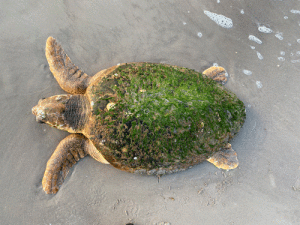
Citizens Asked to Report Sea Turtles Seen on Beaches, Shorelines to 1-866-TURTLE-5
With a record number of threatened loggerhead sea turtle strandings occurring on the Texas coast this year, the U.S. Fish and Wildlife Service and local partners are urging citizens to report any turtles seen on the beaches or shorelines so that they can be rescued, transported and cared for by Service-permitted rehabilitation facilities.
Between April 1 and Aug. 19, 282 loggerheads have stranded in Texas, mostly in the Coastal Bend, between Calhoun and Kleberg counties.
“This is more than twice the average annual number of loggerhead strandings recorded from 2012 to 2021, which was 109, and annual numbers have increased during this decade,” said Donna J. Shaver, Ph.D., Texas Coordinator of the Sea Turtle Stranding and Salvage Network (STSSN) and Chief of the Division of Sea Turtle Science and Recovery at the National Park Service’s Padre Island National Seashore. “This dramatic increase in loggerhead strandings this year is alarming and has STSSN participants on high alert in the Coastal Bend to be ready for the increased influx of incapacitated loggerheads needing immediate rescue and care.”
Loggerhead sea turtles are one of five species of sea turtle known to inhabit the Gulf of Mexico. Adults are about three feet long and can weigh up to 350 pounds.
“In the Coastal Bend, around one third of the stranded loggerheads have been found alive and are receiving care at permitted rehabilitation facilities, including the Amos Rehabilitation Keep (ARK), Texas State Aquarium, and Texas Sealife Center,” said Mary Kay Skoruppa, U.S. Fish and Wildlife Service Sea Turtle Coordinator for Texas. “The affected loggerheads have been found underweight and emaciated. They are receiving diligent care in rehabilitation, and we hope that most will recover and ultimately be released back into the Gulf of Mexico.”
Multiple researchers are investigating possible causes of these strandings. According to Dr. Shaver, the increase in strandings may be habitat-related, such as decreases in prey availability, freshwater inflows, and water quality, and exposure to hypoxic areas and contaminated prey.
To date, infectious diseases, biotoxins, and fisheries-related captures have been ruled out as the causative agents for the loggerhead strandings.
The investigation into the increase in strandings is ongoing and includes detailed necropsy of deceased turtles, extensive sampling of live and dead turtles, and environmental analyses to understand factors that may be contributing to these strandings.
If a sea turtle is seen on a beach or shoreline in Texas, it is either sick or injured, or could be nesting this time of year, and the Service advises citizens to quickly report the sighting by calling 1-866-TURTLE-5 (1-866-887-8535). Callers should be prepared to describe where the turtle is located, whether it appears to be dead or alive, and the size of the animal (estimated weight or length of shell – to know if it will require two or more persons to respond). If possible, callers should stay near the animal to help orient officials and protect the turtle from vehicles or scavengers.
“It takes a lot of coordination among trained, authorized individuals to successfully rescue stranded sea turtles,” Skoruppa said. “It is therefore critical that citizens report their sightings immediately, so that rescue efforts can begin quickly. Sometimes there are considerable travel distances to remote areas and other rescues may be happening at the same time, so we ask that people be patient after calling to report a stranded turtle.”
After rescue, stranded turtles are taken to authorized rehabilitation facilities where they are assessed and treated for illness or injury. Since sea turtles are protected under the Endangered Species Act, rehabilitation facilities in Texas must be permitted by the Service, meet high standards for specialized care, and have appropriate experience to treat sea turtles. Once medically cleared by a veterinarian, the turtles are released back into the Gulf of Mexico.
Organizations and individuals involved with the rescue, transport, medical assessment, and care of stranded sea turtles in the Coastal Bend include Padre Island National Seashore – Division of Sea Turtle Science and Recovery, Texas Parks and Wildlife Department, National Oceanic and Atmospheric Administration (NOAA) Fisheries, ARK, Texas Sealife Center, Texas State Aquarium, Texas Master Naturalists, Triton Environmental Solutions, LLC, JM DavidsonEngineering, Keep Aransas County Beautiful, and many citizens who have reported stranded turtles and assisted with rescues while recreating off the Texas coast.
The U.S. Fish and Wildlife Service works with others to conserve, protect, and enhance fish, wildlife, plants, and their habitats for the continuing benefit of the American people. For more information on our work and the people who make it happen, visit http://www.fws.gov/. Connect with our Facebook page, follow our tweets, watch our YouTube Channel and download photos from our Flickr page.
http//www.fws.gov/southwest/
